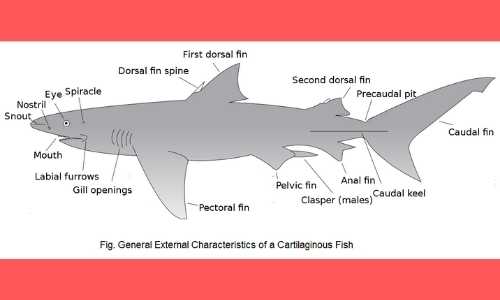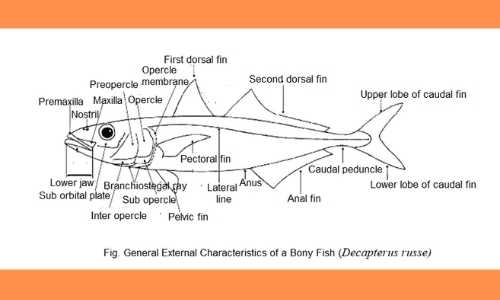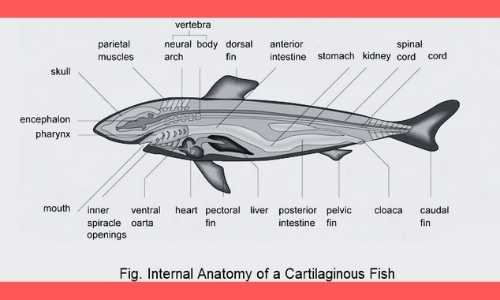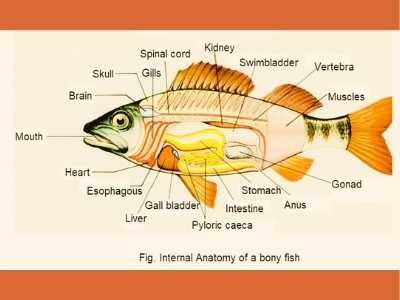Fish is a primitive jawed vertebrate animal (Phylum: Chordata). They are cool-blooded aquatic animals that breathe and move with the help of fins. Fish originated in the Ordovician period and spread in the Devonian period. That is why Devonian is called the golden age of fish. The study of fish is called Ichthyology. Fish are more distinct in size, shape, habitat, and habituation than other vertebrates.
The smallest fish in the world is Mistichthys lozerensis (Philippine Gobi) which is about 1.2 cm in length and the largest fish is Rhincodon (whale shark) which grows up to 21 meters long. Fish live in different types of water bodies including rivers, seas, lakes, reservoirs, ponds, etc. Among animals, they are economically important.
Fish is used in food and fish liver is the main source of vitamins A and D all over the world. Fish oil is used in the soap and tannery industries. Besides, people entertain themselves by keeping beautiful colorful fish in the aquarium.
General Characteristics of Fish
The general characteristics of fish are mentioned below:
1. Fish are aquatic animals that live in all types of water bodies. They live in freshwater (Labeo), marine (Pampus), estuarine water (Chanos) and cool water (Salmo).
2. Symmetry: They are bilaterally symmetrical.
3. Coelom: Fish are eucoelomate or enterocoelomate type animals.
4. They are triploblastic animals.
5. Segmentation: Fish are segmented animals and their segmentation is internal.
6. Shape: Most fish are spindle-shaped. Some fish are dorso-ventrally compressed (Narcine), some are laterally flattened (Notopterus), some are snake-like (Mastacembelus), and some are globe-shaped (Chelonodon).
7. Color: There are different types of colors in fish. Aquarium fish have glossy colors.
8. Size: The size of the fish is 1.25 cm to 20 meters in length.
9. Exoskeleton: The body of the fish is covered with scales. It is known as the identity of fish for their various types of work. The scales are mesodermal in origin. Representatives of order Siluriformes have no scales. Some fish do not have scales in the head area (Major Carp). The bony ridge exists in Hippocampus (Syngnathiformes). There are different types of scales, such as cosmoid (extinct fish), ganoid (Dipnoi), cycloid (Cypriniformes), and ctenoid (Perciformes). Some fish have spines on their bodies (Clarias).
10. Fins: Fish fins are used for swimming and maintaining balance. Fins contain fin rays that are thorny and soft. The fins without rays are known as adipose fins. The fins are mainly divided into paired and unpaired. The paired fins are the pectoral and pelvic fins. Unpaired fins are dorsal, anal, and caudal fins. The fins are normal in most cases. However, in some cases, they have been transformed.
11. Body structure: The body of the fish is divided into head, trunk and tail.
12. Tail: The tail plays a role in changing direction while swimming. The tail bears a fin called the caudal fin. There are different types of caudal fins, namely, diphycercal fin (dipnoi), hypocercal(extinct fish), heterocercal (cartilaginous fish), and homocercal (teleost). The caudal or tail fins are forked or round or attached to the dorsal and anal fins.
13. Endoskeleton: In most cases, the endoskeleton consists of an autostylic skull and amphicoelous vertebrae. The appendicular skeleton is poorly developed.
14. Digestive system: The digestive system of fish is complete. The mouths of carnivorous fish are large and the mouths of other fish are small. The mouths are marginal (many fish), curved upwards (Catla), sub-marginal (Labeo), and ventral (cartilaginous fish). The teeth of carnivorous fish are well developed. Many fish do not have a stomach but have an intestinal bulb. Cartilaginous fish have spiral valves that are used to absorb food. Cartilaginous fish have a cloaca. The pancreas of fish is well-formed. Digestion of fish is an intercellular type.
15. Respiratory system: In fish, the process of respiration is performed through the gills. The gills are located in the branchial chamber. The cartilaginous fish has 5-7 pairs and the teleost fish has 3-5 pairs of gills. Each gill consists of a gill arch, gill lamellae, and gill raker. Plankton-eating fish have well-developed gill rakers. In this case, it is used for filtering. Cartilaginous fish have an open and bony fish have a closed type branchial system. Opercula exist only in bony fish. There are more than one pair of external gill openings in cartilaginous fish while bony fish contain one pair of gill openings. Hemoglobin is a respiratory pigment. Some fish such as Clarias (respiratory tree), Channa (labyrinth organ), Heteropneustes (air sac), lungfish (lung), etc. have accessory respiratory organs which help the fish to survive out of the water for some time.
16. Circulatory system: Blood circulatory system of fish is a closed type. The heart has two chambers with venous, tubular, and conus or bulbous arteriosus. Red blood cells are bi-convex type.
17. Nervous system: The cerebrum is not well developed. In particular, the olfactory lobe of sharks is well developed. Fish have 10 pairs of cranial nerves.
18. Sense organ: Lateral line organ is well developed in fish. Neuromast cells are found in this organ which helps in the detection of water current. The external and middle ears are missing. The inner ear exists as a membranous labyrinth. The olfactory organs are well developed with olfactory lamellae. The cartilaginous fish has a heat-sensing organ called the Ampullae of Lorenzini. Catfish have well-developed barbells.
19. Excretory system: Mesonephric kidney exists in fish. The blood of marine fish contains urea which maintains the isotonic state of fish blood with seawater.
20. Reproductive system: Fish are monoecious animals. They show sexual dimorphism. Some fish have mating organs. Clasper is used as a mating organ in cartilaginous fish and Gonopodium is in the fish under family Poeciliidae. The size of the fish gonads varies from season to season.
All fish are oviparous except sharks and fish under the family Poeciliidae. External fertilization occurs in fish. The eggs of all the fish except the above fish are of megalecithal type. Cleavage is holoblastic, determinate type. All fish have direct embryonic development except Anguilla. Elever or leptocephalus stage exists in Anguilla. Parental care occurs in fish such as the Oreochromis keeps their baby in their mouth, Hippocampus bears brood sac while some fish that build a nest, such as a sunfish.
21. Many fish have electric organs that can generate electricity, such as Narcine, Electrophorus, etc.
22. Some fish have bioluminescence, such as Blepherodon.
23. Some fish, especially Anguilla, Tenualosa, Salmon, etc., perform diadromous migration.
Number of Living Species of Major Fish Groups
All fish species are divided into six groups. The different groups of fish and their species are mentioned in the following table:
| Name of Group | No of Species |
| Hagfish (Myxini) | 70 |
| Lamprey (Cephalaspidomorphi) | 38 |
| Cartilaginous fish (Chondrichthyes) | 960 (3.4% of all fish) |
| Bony fish (Actinopterygii) | 27,300 (96.2% of all fish) |
| Coelocanth (Crossopterygii) | 02 |
| Lungfish (Dipnoi) | 06 |
| Total | 28,400 |
Bony fish have calcium-containing skeletons and are usually covered by thin scales (except Siluriformes). There are two types of cartilaginous fish, namely sharks and batoids. Skates, rays, and sawfishes are collectively called batoids. Sharks are usually torpedo-shaped and their gill openings are located on the lateral side of the body, whereas the body of batoids is flattened and the gill openings are located on the vertical side of the body. Chondrichthyes are classified as sharks, rays, and skates due to their cartilaginous skeletons, while lampreys and hagfish also have cartilaginous skeletons but they are called Agnatha or primitive fish because they have no jaws. There is also another group of cartilaginous fish called chimeras. All types of ratfishes include here. They have short, rounded snouts and long and pointed tails. They also have a pair of external gill openings and their body have no scales.
28,400 fish species belong to 515 families and 4494 genera. More than half (534 or about 55%) of the 960 living species of cartilaginous fish (sharks, rays, chimeras) are rays. Actinopterygians or bony fish account for about 96% of all living fish, but the remaining fish, except for 51 species or about 0.18%, belong to the group Teleostei.
The 9 largest families of the 515 families include about 9,300 or 33% of all species. These families include Cyprinidae (about 220 genera and 2400 species), Gobiidae (about 210 genera and more than 1950 species), Cichlidae (112 genera and 1350 species), Characidae (about 165 genera and 962 species), Loricariidae (about 92 genera and 684 species), Balitoridae (about 59 genera and 590 species), Serranidae (about 64 genera and 475 species), Labridae (about 68 genera and 453 species), Scorpaenidae (about 56 general and 418 species).
There are 64 monotypic families, meaning that it contains only one species. There are 100 or more species in 67 families and more than 1000 species in 3 families. The average number of species on a family basis is 55. About 300 new species are included each year all over the world
.





